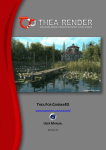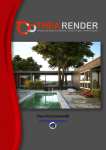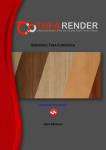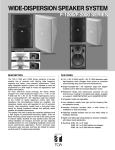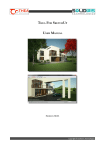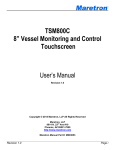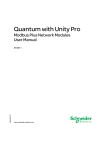Download THEA FOR CINEMA4D
Transcript
Image by Zoran Gorski THEA FOR CINEMA4D www.thearender.com/cinema4d USER MANUAL Revision 01 Copyright © Solid Iris Technologies 1. INTRODUCTION Thea for Cinema4D is an integrated version of Thea Render inside Maxon Cinema4D application. With the use of Thea Material Lab and Libraries, the Interactive Render and Instancing Support you are able to render your scene directly inside Cinema4D. With the Export to Thea Studio functionality you can also stage your scene inside Thea Studio application and benefit of the advanced tools present there. At this manual we will see the basic installation and getting started steps along with the Thea plugin settings panels inside Cinema4D. For seeing the Getting Started video, find Material Libraries and Download links, please visit Thea for Cinema4D landing page at www.thearender.com/cinema4d Note that this manual is covering the plugin settings and options only, so for a deeper and more detailed explanation of Thea settings, materials, engines etc., you can refer to Thea Render User Manual. 2. APPLICATION PREREQUISITES While the plugin could be used as a standalone application there are still dependencies of the plugin from the main Thea Render application. These dependencies are typically the need to open Thea default material editor but also to be able to access Thea data folder (materials, rooms, sample data, etc.). This means that Thea Render should be already installed on your computer (it doesn't matter whether you have installed the 32-bit or 64-bit variant though). On MacOSX platform, make sure that you have also run Thea application at least once (after your drag & drop it typically to your Application folder) in order to complete the installation process. Note that the plugin will work on OSX 10.5 and above and not on OSX 10.4 (Tiger). Cinema4D version should be R12, R13, R14 or R15. The plugin won't run in previous Cinema4D versions. Note that the plugin is incompatible with the developed plugin for R11/R11.5, so it won't be possible to transfer your work between the plugins. 3. INSTALLATION 3.1 Windows The plugin comes with an installer that helps you define the version of Cinema4D to which you want to install the plugin and also its directory. The installer guides you through all the necessary steps of installation. Figure 1: Installing Thea for Cinema4D 2 Copyright © Solid Iris Technologies 3.2 MacOSX Thea for Cinema4d for MacOSX comes with a dmg file. Inside this dmg file you will find a Thea Render folder. Drag and drop this folder inside plugins folder of Cinema4D installation (or user preferences folder). Then, whithin this folder, you will find four separated zip folders; one for each Cinema4D version. Select the needed one, according to your version, and simply double click on it to be extracted. Plugin is ready for use just afterwards. It is recommended to install also the corresponding version of Thea Render standalone as well. Figure 2: Thea Render is available at The next time that you will start Cinema4D, the plugin should be Cinema4D plugins there, under the Plugins menu (see Figure 2). 3.3 Installing Material Library Additionally, you can download a material library that allows easier and more direct use of Thea materials (note that this library is platform independent). For installing the Materials library, you should simply extract the library to Cinema4D content browser user libraries. Tip 1: if you face problems to locate the correct folder where Cinema4d stores its material libraries (lib4d format) you can find the correct path by going to Cinema4D Edit > Preferences and Figure 3: Material Libraries inside Content Browser see that path at the bottom. At this location, inside the “library” folder, you can find the “browser” folder where the Thea Library can be added. Tip 2: if you have successfully installed Thea Materials library, you should be able to access it in the Cinema4D content browser (see Figure 3). With a right click on one of the appearing materials, you can select the Show in Explorer (for Windows) or Show in Finder (MacOSX) for seeing the installation directory of the library. You can now drag and drop the selected material on a Cinema4D model or your materials window. 3 Copyright © Solid Iris Technologies 4. LICENSING AND ACTIVATION To run the plugin in a no demo mode (meaning without resolution limitation and watermarks), you will need to activate your license. This is done by going to Plugins > Thea Render > License (see Figure 4). A new dialogue box opens to help you add your full name, email address and serial number for activating the plugin (see Figure 5). Do not forget to add also the Thea for Cinema4D plugin serial at the plugins tab (see Figure 6). Afterwards restart your application for the changes to be applied. For finding more details on licensing, please refer to Thea Render User Manual corresponding chapter. Figure 4: License Menu Figure 5: License Input Form window – Main tab Figure 6: License Input Form window - Plugins tab 5. GETTING STARTED – MAIN WINDOWS After installing correctly the plugin, you will be able to find its main options at the Plugins list (as we have seen in Figure 2), from where you can open the Darkroom and start an Interactive or a normal rendering. Thea Render can be also found at the Renderers list at the Render Settings window of Cinema4D. You can go to Render > Edit Render Settings (or press CTRL+B) and at the available Renderers list select Thea Render (see Figure 8). From this menu you can define the settings for Output and Save (in the same way as for the native renderer) and for Thea Render specifically. At the next paragraphs we will see the available options for both Plugins menu and Render Settings window. Figure 7: Thea Render appearing at the Plugins list 4 Figure 8: Render Settings window Copyright © Solid Iris Technologies 6. THEA PLUGIN MENU OPTIONS As we see in Figure 9 user can select to open Thea Darkroom for rendering interactively or normally inside Cinema4D, Export the scene for open it later at Thea Studio, Convert Cinema4d materials to the corresponding Thea ones, define the used CPU and GPU devices, check for existing plugin and resources Updates, activate Thea License, edit the main plugin Preferences and see some main information at About window. Figure 9: Plugin Menu options All these options are analyzed in detail at the next tables. 6.1 Thea Darkroom The Darkroom command opens a window that resembles Thea Darkroom, as we see it in Figure 10. Thea Darkroom consists of several menus which help you render and post process your rendered image (which appears in the middle Area B). At this window, you can render the current scene inside Cinema4D using the defined Thea engine (it can be selected at the Render Settings window) or make an interactive render. Figure 10: Thea Darkroom inside Cinema4D Figure 12: Send to options Figure 11: Save options On top, on area A, we can see the menus File and Interactive. File menu: opens the submenus Save, which saves the rendered image in one of the available formats (see Figure 11), and the Send to, which opens the rendered image at Thea Studio Darkroom (Image Editor), at Thea Studio Viewport (Scene Editor) or at Cinema4D Picture Viewer (see Figure 12). Interactive: the drop down menu allows the selection of the engine for the Interactive rendering (see Figure 13). Engines settings can be found at the Render Settings window as we will see later. Resolution submenu helps you define easily the needed rendering resolution (see Figure 14). Figure 13: Interactive Render Engine Core selection Figure 14: Available Resolutions 5 Copyright © Solid Iris Technologies At area C of the Darkroom, we can see the Render Status Bar. Figure 15: Render Status Bar Store button sends the rendered image directly to the Cinema4D picture viewer. The Save button prompts for saving the image with the given format – don't forget to include the extension with the name (it can also be img.thea for whole buffer or clm for Colimo project files). Refresh button is used for refreshing the image once a change at the Exposure or Filtering settings has been made. IR button starts the interactive rendering that allows seeing any movement, material change or light addition interactively. Start button on the other hand, starts the actual rendering (not interactive) according to the engine that is selected at the Render Settings window. Below, at area D, all the available Display option such as Exposure, Filtering, Channels and Photometric Analysis options appear. They work in the same way as inside Thea Studio Darkroom, so for additional details please refer to Thea User Manual corresponding chapter. Figure 16: Darkroom Display options 6.2 Export to Thea The Export command prompts for saving a Thea scene that you can open afterwards within Thea Studio. By selecting the Export option (see Figure 9) you are able to export your scene in scn.thea, pack.thea or xml format. A window opens that allows you to specify the scene name and location. Note 1: export the scene is not possible while rendering. Note 2: at Preferences window (as will be described later) you can select the default extension for saving your scene and also enable/disable opening directly your scene after exporting to Thea Darkroom or Viewport. 6.3 Figure 17: Save Thea Scene window Convert Materials With this option you are able to convert the Cinema4D materials to the corresponding Thea Materials. After pressing the Convert Materials button, a dialogue box appears (see it in Figure 18) that allows you define if you want to convert the selected or all the materials of your scene or simply cancel the procedure. After converting a material to a Thea one, from now on the Thea materials attributes will appear for editing the material. Note: Cinema4D materials are automatically read as Thea materials when rendering starts (even if you have not converted them) without affecting your materials settings and type. 6 Copyright © Solid Iris Technologies Figure 18: Convert Materials dialogue box 6.4 Figure 19: Cinema4D materials and the converted Thea ones Devices The Devices option, allows you to open the Select Devices window (see Figure 20). Here you can see a list with the GPU and CPU devices of your machine, which can be used by Presto engine. At this window, you can enable/disable a device, by clicking to the corresponding box, increase/decrease its priority and define the one that will be used for interactive rendering (currently only one device is used for interactive rendering, while in the Darkroom more devices can be used - CPU & GPU). The [IR] indication appears next to the selected device. At this window apart from the names of the existing devices, you can also see their cores, their memory and other useful information. 6.5 Figure 20: Select Devices window Update The Update button opens the Install Updates window (as seen in Figure 21). At this window user can see the available plugin versions and resources and select which ones wants to install. For more details and options explanations of the Updates window, please refer to Thea User Manual. Figure 21: Thea Updates window 7 Copyright © Solid Iris Technologies 6.6 License The License option, as we have already described, allows an easier activation of your license from within Cinema4D. The first time you want to activate the license, you need to add here your full name, email address, your serial number and at the Plugins tab the Cinema 4D serial number as well, and then ask for an activation code. The system will send you back the activation code and after restarting your application, Thea will be registered. For more details on activation procedure please refer to Thea User Manual. Figure 22: License Input Form window 6.7 Preferences The Thea Preferences window allows you to specify the Default Extension for saving a Thea scene (scn.thea, pack.thea or xml) and also enable/disable the automatic opening of the scene either at Thea Studio (Viewport) or Darkroom. Figure 23: Preferences window 6.8 About The last option found at this menu is the About. This submenu opens a window that gives you some main information for the plugin, such as its current version. Figure 24: About Thea Render window 8 Copyright © Solid Iris Technologies 7. THEA RENDER SETTINGS WINDOW As we have said, by going to Render > Edit Render Settings we can select Thea Render among the existing renderers. At the right side of the window the available settings panels appear (see Figure 25): General, Biased RT, Biased GI, IR, Sky, IBL and Baking. Tip: with the button “Render Setting…” at the bottom, by selecting the New option, you can create and save the needed render presets, for faster selection at the Render menu. Figure 25: Thea Render Settings window 7.1 At the next tables we see the options that exist at each panel and their main functionality. Please refer to Thea manual for the parameterization and a more detailed explanation of the existing settings. General At the General tab (see Figure 26), you can make some basic settings that will affect your render engines. You can select among the existing render engines, the one that will be used as default once you start rendering. For easier and faster settings, available presets also exist which actually override all the other settings, if they are selected. Several other options exist to enable/disable like relight or repaint. At Termination criteria limits for the unbiased engines can be set. Before rendering you can also select the channels that will be rendered too. Tip: by pressing the on the Advanced option triangle button, a new menu appears with more advanced settings. In this way you can show/hide the needed/unneeded panels. 7.2 Figure 26: General tab Biased Engine Settings RT & GI (Adaptive BSD) At the next panels, Biased RT (Ray Tracing) and Biased GI (Global Illumination), all the needed settings for the Adaptive BSD engine are listed. By selecting as default engine the Adaptive (BSD), you can make here all the necessary adjustments (see 9 Copyright © Solid Iris Technologies Figure 27 and Figure 28). At the Biased Ray Tracing panel, you can specify the Antialiasing options, enable Clay Render and adjust any settings related to Blurred Reflections, Ambient Occlusion and Termination Criteria. At the Biased Global Illumination panel, you can enable Field Mapping technique, Caustics, Final Gathering and adjust the needed Irradiance Cache settings. For more detailed explanation of these settings please refer to Thea User Manual and Adaptive (BSD) engine pdf tutorial. Figure 28: Biased GI Panel Figure 27: Biased RT Panel 7.3 Interactive Render At the Interactive Render panel, you can make all the needed adjustments for the interactive rendering engine. As we saw, you can easily select the IR engine at the Darkroom window, but here you can edit also its settings, such as the Tracing Depth, enable/disable Caustics and Ambient Occlusion. Figure 29: IR Panel 7.4 Environmental Settings – Sky and IBL The last two tables of the render settings affect the Environment; the Sky and the IBL - Image Based Lighting (see Figure 30 and Figure 31). At the Sky panel, Thea Physical Sky can be enabled and edited. For the sun, its position can be set with Polar Angle and Azimuth values or by selecting the Location/Time of the scene. At the IBL panel Image Based Lighting, Background, Reflection or/and Refraction Mapping can be enabled. Wrapping, Rotation degrees and Intensity of the maps can be adjusted. 10 Copyright © Solid Iris Technologies Figure 31: IBL Panel Figure 30: Sky Panel 7.5 Baking At the Baking panel, user can select to enable, disable or disable by default texture baking for the selected scene. Note that texture baking is currently (internally) disabled during interactive rendering and material preview generation for performance reasons. Figure 32: Baking Panel By enabling Baking, all textures will be baked, according to Normal and High resolution given below, except if specified differently by a Thea tag for baking (as we will describe later, at the Thea Tags section). Normal resolution affects all kind of channels textures while High resolution those used for bumping and background. Note that according to these resolution settings (if values are quite big, a delay before rendering starts may occur). By selecting to disable baking, no textures will be baked at all. The next option, Disable by Default, will disable baking, except if one adds a special baking tag to a certain object, where baking is enabled (see Figure 34). In this way, texture baking will be generally disabled, but enabled for the tagged objects only. Figure 33: Baking Modes Figure 34: Thea Bake tag 11 Copyright © Solid Iris Technologies 8. CINEMA4D MATERIALS (NATIVE) Cinema4D materials are automatically converted to Thea materials when rendering begins (without affecting your materials inside Cinema4D. There are special heuristics that are used in the conversion process; nevertheless, the result may look quite different from how the material looks using Cineam4D internal renderer. With the Convert Materials (as we saw previously) you are able to convert the Cinema4D materials to the corresponding Thea ones for allowing editing with the Thea Materials settings. Other materials (from other plugins) are not supported. In this case, Thea will render them black. Cinema4D (procedural) shaders are supported only through texture baking. Texture baking can be controlled using Thea Render settings and Thea Bake tag (as we will analyze later on). 9. THEA MATERIALS Thea for Cinema4D can make full use of Thea Material Lab but also allows editing of materials from within Cinema4D. With the use of the Material Library you can also simply drag and drop a Thea material at your model. At the next paragraphs, we will see the available ways to create, edit and use a Thea Material inside Cinema4D. 9.1 Editing a Thea Material within Cinema4D The first step is to create a Thea Material. For this you have to follow one of the following ways: Version R12: Top Menu > File > Thea Material (or from the Materials window) Version R13: Top Menu > File > Shader > Thea Material (or from the Materials window) Version R14 and R15: Top Menu > Create > Material > Thea Material or at the Materials window Create > Shader > Thea Material (see Figure 35). The material created in these ways, will be initially a white basic material and will be added at the Materials window (see Figure 36). Figure 36: Thea Material (initially) Figure 35: Create a Thea Material Another way to create a Thea material is the conversion of the Cinema4D material to the corresponding Thea material, with the use of the Convert Materials button. 12 Copyright © Solid Iris Technologies After creating the material, it is possible to edit it inside Cinema4D, by single clicking on the material. The custom material editor for Thea materials inside Cinema4D, is a simplification of the standard Thea material lab (see ti at the material Attributes panel). Here you can edit a material that has at most two components of the same type (i.e. at most 2 coatings, 2 glossy substrates, etc.). Initially, the empty material comes with the General and Matte options (see Figure 37). Below we see what options exist at each tab. Tip: By enabling a component, the corresponding tab also appears where the component available settings exist. Note: for more details on Thea materials and their settings, please refer to Thea User Manual, at the Material Lab chapter. Figure 37: Thea Material Settings (Attributes panel) At the Basic tab you are able to add/remove components to the material (as we said the maximum is 2 components of each type). At our example, as seen in Figure 38, we have enabled the Matte and Thin Film components. We see that the Thin Film tab also appears on top tabs list. Figure 38: Basic information At the General panel you can edit some basic material settings (such as Repaintable, Tracing Depth etc.) and you can also alter the material room used for the material preview and its quality (passes). Figure 39: General Panel 13 Copyright © Solid Iris Technologies Tip: with Shift+Click on the wanted tabs, we can enable and see more than one panel at the same time, one below the other. As we see in Figure 40, we can have all the needed settings for the Matte and Thin Film component available. Their Scattering, Fresnel, Structure, Layer, etc. panels, with their corresponding settings are each time available. Note: Matte, Thin Film, SSS (Subsurface Scattering), Glossy and Coating are the five basic Thea Materials components. Each comes with different set of special settings, which are present at the corresponding panels. Figure 40: Matte and Thin Film panels At the Description panel we can see and add a description for the Thea material and at the Assign tab be able to see on which model(s) the material is used. Figure 41: Description and Assign panels 9.2 Editing a Thea Material with the Material Lab Editing the material using Thea standard material lab is also possible by double clicking on the material icon (inside Materials window). This will employ Thea Material Lab as an external application and Cinema4D will freeze until you exit the application. The material will then refresh with the changes that you have made in the material lab. Figure 42: Thea Material Lab 14 Copyright © Solid Iris Technologies 9.3 Adding a Thea Material from the Content Browser As we have already mentioned, additionally to the plugin, you can download a material library with ready-to-use materials (please visit www.thearender.com/cinema4d for more details). After installing the library at the browser folder of Cinema4D, you can find the library inside the content browser (see Figure 43) or load the material from the materials window (Create > Load Material Preset > Thea Materials – see Figure 44). Tip 1: as we have already mentioned, if you face problems to locate the correct folder where Cinema4d stores its material libraries (lib4d format) you can find the correct path by going to Edit > Preferences and see that path at the bottom. At this location, inside the “library” folder, you can find the “browser” folder where the Thea Library needs to be added. Figure 43: drag and drop a material from the content browser to your model Figure 44: Thea Libraries can be accessed too from the Materials window 10. LIGHTS Cinema4D point lights are automatically supported by converting them to the corresponding Thea point light. The area lights are also being supported and are always emitting light following inverse square law (note: at the moment, only the following types are supported: Area, Disc, Rectangle, Sphere, Cylinder, Cylinder and Perpendicular). If you want to use a Thea custom area emitter though, you should create it as a Thea material and assign this like a normal material to a model. Figure 45: dragging a light with a Thea Sun Besides the point lights, Sky is also being supported tag changes Thea sun position enabling automatically Thea physical sky (at Render Settings window, at Sky tab). There is also the custom Thea Sun tag that we will see analytically later, which you can assign to any point light; in this way you can adjust Thea sun-sky easily by dragging this common point light around the scene. With the use of Thea light tag, which you can add to any Cinema4D light, you can override its settings and make it behave like a Thea point light (see more details to Thea Tags section). 15 Copyright © Solid Iris Technologies 11. ANIMATION Thea Render can support animation from Cinema4D by rendering the desired key frames from the animation bar. After setting up your animation you can go and select as render engine Thea Render (at Render Settings), then at Output panel define the needed frames that will be rendered (see Figure 47). At the Save panel, specify also the Output folder, where the rendered image sequence will be saved (see Figure 48). Important Note: currently, for animations, you need to start your rendering from the Picture Viewer of Cinema4D, as Thea Darkroom will only render the current frame. Figure 46: setting up the animation Figure 47: select the desired frames Figure 48: define the output folder 12. TEAM RENDER SUPPORT Thea Render can be also used by the Team Render of Cinema4D which allows using other machines for network rendering. You only need to setup Team Render as always (enable it, run clients and add machines). Select Thea Render as render engine and start rendering with Team Render at the Team Viewer. The rendering of the frames will be split among the server and the clients. Thea client or Studio should be enabled to the client machines as well. Note that co- Figure 49: Frames rendering is split to server and operative rendering on the same frame using client Team Render is not yet supported; currently, you can only use Thea Render network rendering for co-operative rendering on still images and not Team Render. Important Note: for allowing Team Render to set up the network rendering and not Thea server itself, at the Network settings of Thea (see Distribution at General panel) Network should be set to None to avoid any network conflicts. 16 Figure 50: Thea Server is disabled when Team Render needs to be used Copyright © Solid Iris Technologies 13. THEA RENDER TAGS Thea Render gives you the possibility to add some additional tags to the Cinema4D objects. These are the following: Thea Bake, Thea Camera, Thea Light and Thea Sun. At the following tables we analyze each of these tags. Note: for more detailed explanation of Thea Cameras and Lights settings, please refer to Thea manual. Figure 51: Thea Render Tags Figure 52: Thea Tags; Sun, Camera, Light and Bake 13.1 Thea Bake Tag As we have already mentioned at the Preferences Settings window, texture baking can be either enabled to the scene by default, be disabled or be disabled by default. With this tab, the enable and disable by default options can be overridden to the selected materials. For the certain material, there is the option to enable baking, disable it or leave the default option (which follows the hierarchy selection of the option or general settings). Below, there is the option to select different resolutions and override the default ones by checking the corresponding box. Figure 53: Thea Bake tag 13.2 Thea Camera Tag The next tag that we can use is the Camera tag. This tag can be added at a Cinema4D camera and allow usage of Thea Camera settings for it (if the option Override C4D Physical Camera is enabled). By enabling the Override Thea Display option, some different settings than the general ones can be set for this selected camera. This means that once this camera is used, at Darkroom, Display options will be changed. Animation of these settings is also available; this allows easy camera display settings change and adaption, during an animation, where lighting conditions may change. 17 Figure 54: Thea Camera tag Copyright © Solid Iris Technologies 13.3 Thea Light Tag Thea Light tag can be added at a Cinema4D light and make it behave light a Thea point light (if the Override C4D Point Light option is enabled). Figure 55: Thea Light Tag At the Type drop down list we can select to change the Thea Light type among Omni, Spot, IES and Projector. This allows easy change of the lights type without the need to re insert it. For each selection the corresponding options appear which allow you to control each light settings (see Figure 56). Figure 56: The Lights per Type 13.4 Thea Sun Tag Thea last tag is the Sun tag, which can be added to a Cinema4D light and allow Thea sun position change by dragging the light accordingly. There are no special settings for this tag. Figure 57: Thea Sun Tag Image by George Drakakis For more plugin details, download links and resources please visit www.thearender.com/cinema4d 18 Copyright © Solid Iris Technologies



















